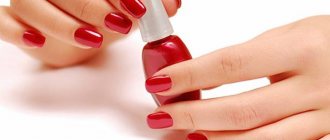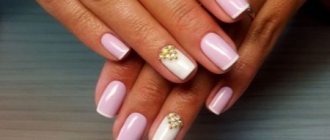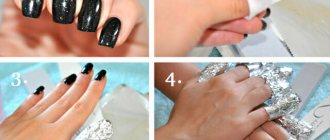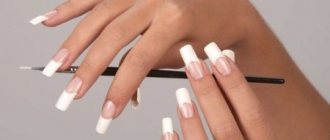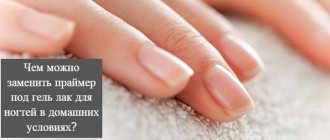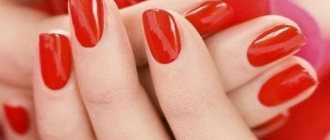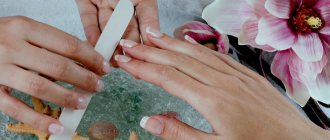Is it possible to wear gel polish for 3 weeks? What if I wear gel polish for a month? Or is it better to do a new one after two weeks of wear?
Technologists do not recommend wearing gel polish for longer than 2-3 weeks. No, this is not because gel polish is harmful, your nails need rest or anything else. All this is nonsense, the reason is different.
I decided to write this post when today I was once again freaking out about my overgrown nails. Overgrown nails are wildly inconvenient, and they also break easily from any careless movement.
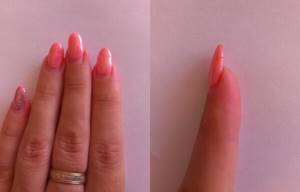
This is what my nails look like after a month of wear. Not pretty. One nail is cracked and will need to be repaired.
The necessary theory about the wearing time of gel polish
Nails grow - this is the main reason that forces us to update our manicure and re-cover them with something.
Look, when you come to the master, your old coating is removed and gel polish is applied to a clean nail. So?
When a master coats your nails with gel polish, he must not just apply the base to you first, then the gel polish, and then the top coat. No, the master shapes the nail architecture. The correct architecture allows you to wear gel polish on your nails longer.
There is such a thing as a nail stress zone - this is the place where the nail most often breaks.
When the master forms the correct architecture, the stress zone is closer to the base of the nail. Closer to the cuticle. That is why you are unlikely to break a nail on which gel polish was applied yesterday.
As the nail grows, the stress zone moves from the base to the edge of the nail. The length of the nail also increases. At the same time, the risk of breaking a nail increases.
Therefore: it is recommended to wear gel polish on your nails for 2-3 weeks.
This time is enough to enjoy a new manicure, show off to your colleagues at work, or go to the sea, but not enough for your nails to grow and begin to cause you discomfort.
Nail techniques that allow you to do manicures less often
- European manicure
This type involves treating the nail plate and the skin around it without cutting the cuticle. Fingers and hands immediately take on a well-groomed and neat appearance. European manicure does not allow the use of cutting tools. An exception may be tweezers if there are burrs on the side rollers. Therefore, the risk of injury is minimal. A variation of European manicure is hardware manicure. The master does not cut the cuticle, but removes dead cells from its surface using a special device. Not all girls know how often they can get a hardware manicure. Professionals advise - no more than 2 times a month.
Sign up for eyelash extensions at Anna Klyuchko's studios with a 15% discount until February 8
12 studios throughout Moscow, St. Petersburg, Nizhny Novgorod and Tula
223 masters for every taste
High-quality service with a 7-day guarantee
Regular promotions and gifts for clients
Full volume 1990₽ 1692₽ Double volume 2590₽ 2202₽ Triple volume 2890₽ 2457₽ Hollywood volume 3400₽ 2890₽
Book 15% discount
- Spa manicure
The purpose of the procedure is to restore the skin and the integrity of the nail plate. It is carried out in beauty salons or at home. Suitable for people with weakened, brittle nails and excessive dry skin.
How often do you get a manicure at the spa? About once every 2-3 weeks, depending on the condition of the nails and hands. This kind of care is especially relevant in autumn and winter. At this time, the body is weakened and receives fewer vitamins and essential microelements. As a result, the skin, hair and nails become dry and do not look very attractive. To maintain the epidermis and nails in normal condition, it is important not only to get a spa manicure, but also to take multivitamins and eat right.
Together with strengthening and rejuvenating procedures, you will get excellent results.
- Japanese manicure
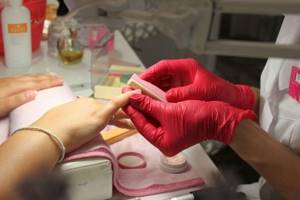
Asian manicure is aimed at performing several tasks at once - skin rejuvenation, restoration and strengthening of nails. The master uses only natural care products and safe tools in his work. As a result, natural processes of rejuvenation and restoration are launched. The nail plate is saturated with calcium, zinc, vitamins, etc.
Japanese manicure is suitable for those with weakened and thinned nails that lack microelements for a sufficient regrowth rate. If the manicure is done without a coating, it does not need to be done as often as with varnish. Nails look natural, but at the same time well-groomed. The procedure has a number of features:
- the master uses only natural care products and does not use cutting tools;
- the procedure is safe and suitable for pregnant and lactating women;
- With regular care, after a couple of weeks the result will already be noticeable;
- manicure can be performed together with other cosmetic procedures or separately;
- The procedure can be done at home, you just need to purchase care products.
Before starting any manipulation, you need to disinfect the instrument and sanitize your hands. Yes, the masters do not use sharp or cutting objects, the risk of getting wounded, and therefore causing infection, is minimal. But surfaces also contain bacteria that pose a risk of infection.
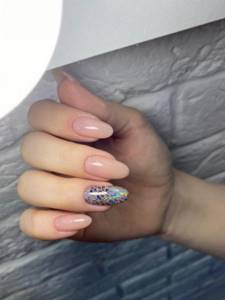
Work done in our studio “Anna Klyuchko”. Sign up for a manicure
Benefits of Japanese care:
- The effect after completing the course lasts for a long time. Even after a break or cancellation of Japanese manicure, the nails and skin of the hands look healthy, moisturized and well-groomed.
- Japanese manicure is recognized as one of the safest. The cuticle is not cut. It is softened with a special serum, and then moved to the base of the nail. Injury to the client is minimized because the master does not use sharp or rough objects in his work.
- Already after the first session the result is noticeable. The technique requires regular visits to the salon and constant care, but after the first visit, nails and hands generally look healthier and take on a well-groomed appearance.
- The procedure is aimed not only at aesthetics, but also at rejuvenation and treatment. Oils, extracts and natural extracts have a beneficial effect on the condition of the skin and nails, but do not affect the body.
- Personalized approach to the client. You will not be offered treatment or recovery until the condition of your nails, hand skin and cuticles has been examined. Initially, the specialist will conduct a thorough examination, after which he will prescribe specific compounds to change the condition for the better.
How to determine the nail stress zone.
How long can you wear gel polish?
You already understand that on average it is advisable to wear a manicure for 2-3 weeks. But still people are different. How can you determine how long you can wear gel polish?
There is a simple test that gives a clear answer to this question.
- Remove the coating to leave your nails clean. Without any coverage at all.
- Press the free edge of the nail so that the part you pressed turns white
- The border between the pink and white parts of the nail will be the stress zone.
As a rule, the stress zone on clean nails is approximately in the middle of the nail, a little closer to the cuticle. Up to this very point you can wear the old coating and not update your manicure.
Every day the stress zone will move closer to the edge of the nail. As soon as it gets very close (in 2-3 weeks), you will have every chance of getting a crack, or even breaking your nail.
What happens if you wear gel polish for more than three weeks?
It all depends on your individual characteristics and the speed of nail growth. If your nails don't grow very quickly, then please. Can you wear gel polish for at least a month?
Is UV lamp harmful for nails?
There is evidence that ultraviolet radiation can contribute to the development of melanoma on the hands and feet. Indeed, with prolonged exposure to ultraviolet radiation, the risk of DNA damage to skin cells and the nail matrix increases. But there's no need to panic, and here's why.
Lamps for drying gel polish usually use UVA or LED radiation. These ultraviolet rays are type A and do not burn the skin. But photoaging and an increased risk of skin cancer as side effects are quite possible under the influence of UVA rays. But only if the skin is not protected and not adapted to ultraviolet radiation.
The nail effectively protects the nail bed: it almost completely blocks UVB and allows only 0.5 - 2.5% UVA to pass through. We also note that the back of the hand, like the face, is more often than other parts of the body exposed to the sun without protection, which means it is well adapted to ultraviolet radiation. So no need to worry.
However, our expert recommends applying sunscreen with SPF 30+ to your skin about half an hour before your manicure.
About the growth rate of fingernails
In an adult healthy person, the nail plate is renewed on average in 2-4 months (depending on who it is). Nails on the left and right hands grow at different rates. If you are right-handed, your nails will grow faster on your right hand. If you are left-handed, then vice versa. Even on the same hand, the rate of nail growth on different fingers will be different. So nails grow fastest on the middle fingers, and slower on the big and little fingers. These differences are so small that visually we do not notice them. But we most often get chips and cracks on those hands and on those fingers where nails grow fastest
Problems caused by wearing gel polish longer than expected
Yes, it's not very beautiful, but it's not the worst thing. The main problem, as I already said, is the risk of breaking a nail. Another problem is detachments of overgrown nails at the base.
You've just had your coating done. At the base, this very coating is hidden under the cuticle, and everything is hermetically “packed.” After a week, the edge of the coating at the base of the nail begins to peek out from under the cuticle (the nail is growing). Further more. The base, which should have been under the cuticle, moves to the edge of the nail and begins to peel off a little in this place. Water, dirt, hair, and everything else begin to clog into this “gap.”
Personally, this is very inconvenient for me. For example, when I wash my hair or do my hair, the hair gets stuck in the areas of detachment at the base, and it’s just terrible. It becomes completely impossible to get yourself in order. Even untying a knot on a grocery bag becomes a problem.
- After 2-3 weeks, the quality of adhesion of the coating to the nail plate decreases, and air pockets and detachments may appear.
- Water, dirt, and any nasty things that get into places where the material is detached can cause the development of pathogenic microflora. The fungus, if you catch it somewhere, will feel great in such places.
Overgrown nails are not only not beautiful and not convenient, they are also a little more expensive. When I once again forget to make an appointment for a manicure on time, I consistently end up with 1-2 cracked nails. These cracks have to be repaired for an additional fee during the next manicure.
So it turns out that irregular visits to the master entail a whole series of problems and inconveniences for the owl?
Avoid cheap materials
Many masters do not want to spend money on high-quality gel polishes, which, as a rule, are quite expensive. But such materials contain substances that are prohibited for use due to their toxic effects on the human body. Such substances include:
- hexanediol 1.6,
- formaldehyde,
- tiluene,
- dibutyl phthalate.
Chinese products do not inspire confidence among experienced craftsmen. Since they do not have such strict control in the production of gel polishes as in the USA and Europe. In cheap Chinese gel polishes you can find in the composition all those substances that can not only cause allergic reactions, but also pigment the clients’ own nails.
The opinion that the base will help protect the nail from low-quality varnish is also wrong. The base prevents the nail from coming into contact with the coating, but this does not protect the nail from toxic materials.
Hyponychium is another reason to update the coating on time
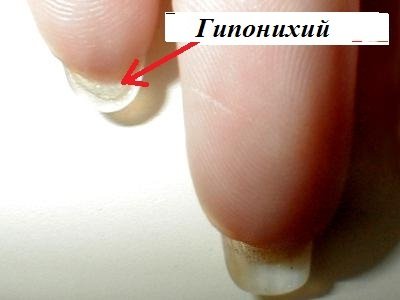
Hyponychium is the skin under our nails. It protects the body from all kinds of infections and viruses when dirt gets under our nails.
Hyponychia can often “stick” to the bottom of the nail plate. If you walk around with gel polish for a long time, the nail grows a lot and pulls out this same hyponychium. And this is a piece of living skin for a moment. The next time you come with overgrown nails for a manicure, and the master starts to remove the length with a file, it will hurt. This is because, along with the nail, the master will file off this very piece of living skin. And there’s nothing you can do about it - just renew the coating in time, and don’t let the hyponychium grow too long.
How to stop wearing gel polish for longer than expected.
As an option, immediately after the next gel polish application, immediately make an appointment with the specialist for the next session. We professionals love it when clients do exactly this. You know in advance that in two to three weeks you are scheduled to visit a manicurist. Personally, I try to contact the client before the appointment and remind her that we have a meeting tomorrow. This is exactly what you need. This way you won’t be able to “oversleep” the moment when you need to update the coverage.
Another option is to set a reminder in your phone. She will remind you every two to three weeks to make an appointment for a manicure. But this method has a big drawback. There is often a “queue” for good masters. If you call the specialist in two weeks in the hope of getting a manicure tomorrow, there may not be any vacancies. Then you will have to wait several days and walk around with overgrown nails, and this, as you yourself know, is not very convenient.
Remember:
- You should not wear gel polish for longer than 2-3 weeks.
- If your nails grow slowly, you can wear your nails longer.
- Determine the stress zone of your nails to know how long you can wear gel polish without the risk of cracks and chips.
- If your nails begin to peel off at the base, break, and the last time you had a manicure was more than a month ago, this is a reason to renew the coating.
- If you see a hyponychium (long edge of the skin) on the inside of the nail, run to a manicure.
please rate the article, I tried 

( 9 ratings, average: 4.78 out of 5)
Is failure to comply with application technology really that dangerous?
An experienced manicurist always strictly follows the technology of working with gel coating. For this reason, there is no point in worrying about the harmfulness of gel polish for your nails. But in the case when the technique is performed incorrectly, the nail plate may break off and peel.
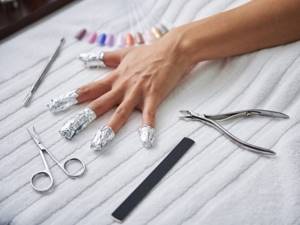
Do not remove the gel coating yourself using solvents at home or tear it off in small pieces. Thus, it is very easy to destroy the structure of the nails, which will lead to their curvature and prolonged treatment.
During the procedure, some masters mistakenly file down the nail plate in the hope that this will hold the gel coating more tightly. The human nail contains an element called keratin. The fact is that the substances contained in the gel, reacting with the varnish, form a very strong adhesion with it. Therefore, there is no need to influence the structure of the nail plate in the form of filing or grinding.
—>
